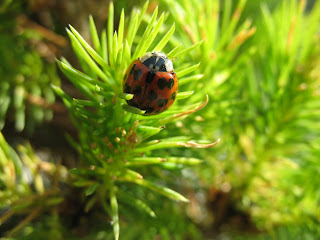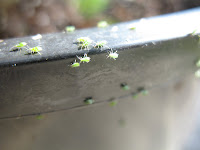We purchased some dwarf Alberta spruce this return to use as our Christmas trees. There were quite small & we had them indoors & decorated for only the week of Christmas. Our aim is to grow them on the floor for a few days before finding homes for them in the yard.
I transplanted them into larger pots this spring & they put out a new stage of needles.

Predatory ladybugs are commonly found on plants where aphids or scaleinsects are, and they lay their eggs near their prey, to increase thelikelihood the larvae will get the prey easily. Ladybugs arecosmopolitan in distribution, as are their prey. Ladybugs also have a root of pollen for nutrient and areattracted to particular types of plants. The most popular ones are anytype of mustard plant, as well as other early blooming nectar and pollensources, like buckwheat, coriander, red or crimson clover, and legumeslike vetches, and too early aphid sources, such as bronze fennel, dill,coriander, caraway, angelica, tansy, yarrow, of the wild carrot family.Other plants that also attract ladybugs include coreopsis, cosmos(especially the white ones), dandelions and scented geraniums.

 They were circling the pot along the rim & then I noticed them all over the spruce itself & it is first to drop needles!!
They were circling the pot along the rim & then I noticed them all over the spruce itself & it is first to drop needles!!
Plants exhibiting aphid damage can have a variety of symptoms, such asdecreased growth rates, mottled leaves, yellowing, stunted growth,curled leaves, browning, wilting, low yields and death. The removal ofsap creates a lack of energy in the plant, and aphid saliva is toxic toplants. Aphids frequently transmit disease-causing organisms like plant viruses to their hosts.
I have isolated it from other plants in the hopes that the aphids won't jump ship & infest the balance up on the deck.
I transplanted them into larger pots this spring & they put out a new stage of needles.
But so I noticed something on the pots. Aphids! I sprayed them off in the hopes they would simply go away, but a week later they had returned.
Something I learned earlier this jump was that prey insects such as aphids, will make a few generations of bearing in the garden to tempt in the predator - so, in order to get rid of the aphids 'naturally' I would have to give them be & hope ladybugs & other predator insects would somehow just see them.
Low & behold:
The Predator

Predatory ladybugs are commonly found on plants where aphids or scaleinsects are, and they lay their eggs near their prey, to increase thelikelihood the larvae will get the prey easily. Ladybugs arecosmopolitan in distribution, as are their prey. Ladybugs also have a root of pollen for nutrient and areattracted to particular types of plants. The most popular ones are anytype of mustard plant, as well as other early blooming nectar and pollensources, like buckwheat, coriander, red or crimson clover, and legumeslike vetches, and too early aphid sources, such as bronze fennel, dill,coriander, caraway, angelica, tansy, yarrow, of the wild carrot family.Other plants that also attract ladybugs include coreopsis, cosmos(especially the white ones), dandelions and scented geraniums.
The Prey:

 They were circling the pot along the rim & then I noticed them all over the spruce itself & it is first to drop needles!!
They were circling the pot along the rim & then I noticed them all over the spruce itself & it is first to drop needles!!Plants exhibiting aphid damage can have a variety of symptoms, such asdecreased growth rates, mottled leaves, yellowing, stunted growth,curled leaves, browning, wilting, low yields and death. The removal ofsap creates a lack of energy in the plant, and aphid saliva is toxic toplants. Aphids frequently transmit disease-causing organisms like plant viruses to their hosts.
I have isolated it from other plants in the hopes that the aphids won't jump ship & infest the balance up on the deck.
No comments:
Post a Comment